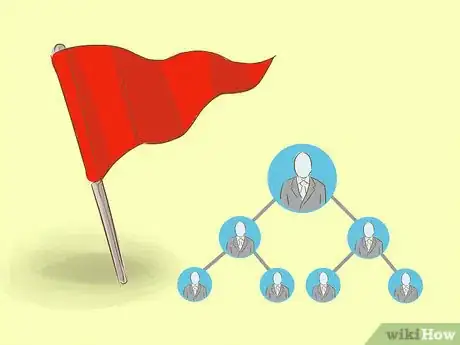This article was co-authored by Jill Newman, CPA. Jill Newman is a Certified Public Accountant (CPA) in Ohio with over 20 years of accounting experience. She has experience working as an accountant in public accounting firms, nonprofits, and educational institutions, and has also honed her communication skills via an MA in English, writing jobs, and as a teacher. She received her CPA from the Accountancy Board of Ohio in 1994 and has a BS in Business Administration/Accounting.
wikiHow marks an article as reader-approved once it receives enough positive feedback. In this case, 81% of readers who voted found the article helpful, earning it our reader-approved status.
This article has been viewed 514,303 times.
If you're looking for a way to make a little extra money, you might be wondering if a sales opportunity is too good to be true. Knowing the difference between legal multi-level marketing and illegal pyramid schemes can help you make the safe decision when considering that job on the side.
Steps
Researching the Company
-
1Find out when the company was founded. All of the top 25 MLMs have been around for 10 years, and most more than 20.[1] There are certainly legitimate startup MLMs, but treat a company that has been around for less than 10 years with caution. Since pyramid schemes are illegal, the top executives generally close their doors as soon as they turn a decent profit.[2]
-
2Do a web search of the company. With the internet, it is easy to find a wide number of impartial sources with opinions about companies. Add keywords like 'scam' or 'reputation' or 'review' to get directly to people's opinions. Though pyramid schemes may hire internet marketers to produce false reviews — another illegal practice — you should find positive as well as negative reviews.
- The Better Business Bureau (BBB) is a good place to start. It is a nonprofit that processes complaints filed against businesses and resolves questions of illegal or unethical behavior.
- Another great resource is The Federal Trade Commission website, which has information on companies that have been pursued or fined for illegal business practices.
Advertisement -
3Look at the company's structure. Due to their large pool of self-motivated underlings, MLMs may seem similar to schemes on the surface. However, the MLMs use this system as a substitution for a larger advertising budget. This work is done instead by salespeople on the ground telling others about their product. If the company emphasizes the work of the executives in recruiting new members in their 'downline' over the role the salespeople play, it is probably a pyramid scheme.
- 'Downline' is a term used by MLMs and pyramid schemes to refer to those who work under you. It can be confusing, since MLMs also give salespeople the opportunity for promotion to a supervisory role.
-
4Look at the compensation. MLMs make their money off sales rather than the contributions of new members. They want to recruit and keep better salespeople, so they compensate them well. Pyramid schemes will glaze over the compensation details of the lower tier to tell you how much money you can make after getting promoted. Push them to give you not only concrete profit margins for salespeople, but actual yearly averages of profit for entry-level workers – not the executives.
- The MLM strategy is to establish a large population of salespeople to distribute the project and increase their sales force exponentially. Promoters get commission on the sale of the product, as well as income for sales their recruits make.
-
5Find out their refund policy. For the pyramid schemes that have, or claim to have, real products, you have to do a little digging to find out if the product is a scam. One way to do this is to find out if you can expect to receive a full refund for unused products. Pyramid schemes often rely on people buying packages of their useless products only to find out that they are unsellable. Then when the people contact the company, they point to the 'no returns' policy in the contract.
-
6Find out how you get promoted. People move up in pyramid schemes based on how many recruits they sign. MLMs promote people based on their sales numbers or similar performance criteria. If you can promote yourself without an official appointment, it is probably a pyramid scheme.[3]
Researching the Business Model
-
1Look at the business model. MLMs should be quite straightforward. The salespeople are recruited to sell large quantities of merchandise to people outside the company. Pyramid schemes rely on exciting promises and buzzwords to cover up the fact that they don't have a legitimate business model. Their actual model would not entice nearly as many people to buy in.
- Business models of MLMs should be easy to understand. For instance, they might have a successful line of hygienic products. Since products like shampoo are inexpensive to produce in mass amounts, there is often a considerable markup for the consumer. Use this method to walk yourself through how the business makes money.
- Business models for pyramid schemes are confusing. They often include fantastical promises about revolutionizing their industry or introducing a 'miracle product.' More importantly, they emphasize the process of recruitment and promotion over the actual product. Don't get lured into the job until you understand how the company makes its money.
-
2Do research into what products they sell. This is the biggest giveaway with pyramid schemes. They often don't even mention what product you'd be selling, but only talk about recruitment and making money off the downline. The products they do sell are often ridiculous and unsellable, picked for the allure of getting rich selling them rather than actually using them. MLMs have useful everyday products that have been sold door-to-door and on the internet for decades.
- Some examples of phony pyramid scheme products are 'miracle cures,' unfamiliar health products at seemingly high prices, or low-cost, high-yield investment opportunities.
-
3Find out how employees make their money. Often, pyramid schemes offer products with a low profit margin. The real money is to be made from recruiting new members. Since these details may not be apparent to someone outside the company, you will need to use these other criteria to make a decision. The product may not be a dead giveaway.
- Let's say, for instance, there was a pyramid scheme that sold inexpensive DVDs.[4] This seems like a legitimate product. But how much profit can you hope to make off each unit? It may be hard to tell. If there is high reward for recruiting members in addition, look for other signs of a pyramid scheme.
-
4Look at the cash flow. Is the company sustainable? Stable businesses depend on a cycle of production, marketing, and sales. Money goes out and comes in. If money only seems to be coming from people inside rather than outside the business, it is not self-sustainable.
-
5Find out what your contribution gets you. If you get a briefcase of popular cosmetics, it may be a safe investment. If you merely get the opportunity to sign other people to work for you, it is probably a pyramid scheme. It has to be a viable business opportunity for everyone from the downline to the executives. [5]
Expert Q&A
-
QuestionHow do I find out whether a specific company is a pyramid scheme?
 Jill Newman, CPAJill Newman is a Certified Public Accountant (CPA) in Ohio with over 20 years of accounting experience. She has experience working as an accountant in public accounting firms, nonprofits, and educational institutions, and has also honed her communication skills via an MA in English, writing jobs, and as a teacher. She received her CPA from the Accountancy Board of Ohio in 1994 and has a BS in Business Administration/Accounting.
Jill Newman, CPAJill Newman is a Certified Public Accountant (CPA) in Ohio with over 20 years of accounting experience. She has experience working as an accountant in public accounting firms, nonprofits, and educational institutions, and has also honed her communication skills via an MA in English, writing jobs, and as a teacher. She received her CPA from the Accountancy Board of Ohio in 1994 and has a BS in Business Administration/Accounting.
Financial Advisor An internet search will be invaluable. Search the company name on your web browser of choice and you will likely find what you're looking for. You can also check the local Better Business Bureau website, the appropriate State Attorney General's office website, or the Federal Trade Commission's (FTC) website and search for any cases or rulings involving this company. You can also search for pyramid schemes on the FTC website and find helpful articles such as "The telltale signs of a pyramid scheme" or "Spotting an illegal pyramid scheme 101."
An internet search will be invaluable. Search the company name on your web browser of choice and you will likely find what you're looking for. You can also check the local Better Business Bureau website, the appropriate State Attorney General's office website, or the Federal Trade Commission's (FTC) website and search for any cases or rulings involving this company. You can also search for pyramid schemes on the FTC website and find helpful articles such as "The telltale signs of a pyramid scheme" or "Spotting an illegal pyramid scheme 101." -
QuestionWhat are the advantages and disadvantages of one product in multi-level marketing?
 Jill Newman, CPAJill Newman is a Certified Public Accountant (CPA) in Ohio with over 20 years of accounting experience. She has experience working as an accountant in public accounting firms, nonprofits, and educational institutions, and has also honed her communication skills via an MA in English, writing jobs, and as a teacher. She received her CPA from the Accountancy Board of Ohio in 1994 and has a BS in Business Administration/Accounting.
Jill Newman, CPAJill Newman is a Certified Public Accountant (CPA) in Ohio with over 20 years of accounting experience. She has experience working as an accountant in public accounting firms, nonprofits, and educational institutions, and has also honed her communication skills via an MA in English, writing jobs, and as a teacher. She received her CPA from the Accountancy Board of Ohio in 1994 and has a BS in Business Administration/Accounting.
Financial Advisor In a multi-level marketing situation, there are usually multiple products to sell because you will have a better chance at making a sale if you have more choices to offer. You can also approach your customer base with new product offerings instead of starting from scratch trying to sell something new. With just one product, disadvantages would include limited interest or customer burnout, product obsolescence, constant need to find new customers. Advantages would be that you could easily become an 'expert' on this product, which should help your sales. If the product was going to be 'new or improved' in any way, it would be easier for the company to accomplish this because it's their only product. Also, all of the company's advertising budget would be spent on just one product, so it should be well-known to consumers.
In a multi-level marketing situation, there are usually multiple products to sell because you will have a better chance at making a sale if you have more choices to offer. You can also approach your customer base with new product offerings instead of starting from scratch trying to sell something new. With just one product, disadvantages would include limited interest or customer burnout, product obsolescence, constant need to find new customers. Advantages would be that you could easily become an 'expert' on this product, which should help your sales. If the product was going to be 'new or improved' in any way, it would be easier for the company to accomplish this because it's their only product. Also, all of the company's advertising budget would be spent on just one product, so it should be well-known to consumers.
-Step-1.webp)







































































